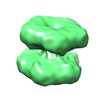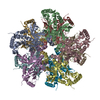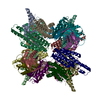[English] 日本語
 Yorodumi
Yorodumi- EMDB-2581: The structures of cytosolic and plastid-located glutamine synthet... -
+ Open data
Open data
- Basic information
Basic information
| Entry | Database: EMDB / ID: EMD-2581 | |||||||||
|---|---|---|---|---|---|---|---|---|---|---|
| Title | The structures of cytosolic and plastid-located glutamine synthetases from Medicago truncatula reveal a common and dynamic architecture | |||||||||
 Map data Map data | gsii-a reconstruction from M. trucantula | |||||||||
 Sample Sample |
| |||||||||
 Keywords Keywords | glutamine synthetases / Medicago trucantula | |||||||||
| Biological species |  | |||||||||
| Method | single particle reconstruction / cryo EM / Resolution: 20.0 Å | |||||||||
 Authors Authors | Torreira E / Seabra AR / Marriott H / Zhou M / Llorca O / Robinson CV / Carvalho HG / Fernandez-Tornero C / Pereira PJB | |||||||||
 Citation Citation |  Journal: Acta Crystallogr D Biol Crystallogr / Year: 2014 Journal: Acta Crystallogr D Biol Crystallogr / Year: 2014Title: The structures of cytosolic and plastid-located glutamine synthetases from Medicago truncatula reveal a common and dynamic architecture. Authors: Eva Torreira / Ana Rita Seabra / Hazel Marriott / Min Zhou / Óscar Llorca / Carol V Robinson / Helena G Carvalho / Carlos Fernández-Tornero / Pedro José Barbosa Pereira /    Abstract: The first step of nitrogen assimilation in higher plants, the energy-driven incorporation of ammonia into glutamate, is catalyzed by glutamine synthetase. This central process yields the readily ...The first step of nitrogen assimilation in higher plants, the energy-driven incorporation of ammonia into glutamate, is catalyzed by glutamine synthetase. This central process yields the readily metabolizable glutamine, which in turn is at the basis of all subsequent biosynthesis of nitrogenous compounds. The essential role performed by glutamine synthetase makes it a prime target for herbicidal compounds, but also a suitable intervention point for the improvement of crop yields. Although the majority of crop plants are dicotyledonous, little is known about the structural organization of glutamine synthetase in these organisms and about the functional differences between the different isoforms. Here, the structural characterization of two glutamine synthetase isoforms from the model legume Medicago truncatula is reported: the crystallographic structure of cytoplasmic GSII-1a and an electron cryomicroscopy reconstruction of plastid-located GSII-2a. Together, these structural models unveil a decameric organization of dicotyledonous glutamine synthetase, with two pentameric rings weakly connected by inter-ring loops. Moreover, rearrangement of these dynamic loops changes the relative orientation of the rings, suggesting a zipper-like mechanism for their assembly into a decameric enzyme. Finally, the atomic structure of M. truncatula GSII-1a provides important insights into the structural determinants of herbicide resistance in this family of enzymes, opening new avenues for the development of herbicide-resistant plants. | |||||||||
| History |
|
- Structure visualization
Structure visualization
| Movie |
 Movie viewer Movie viewer |
|---|---|
| Structure viewer | EM map:  SurfView SurfView Molmil Molmil Jmol/JSmol Jmol/JSmol |
| Supplemental images |
- Downloads & links
Downloads & links
-EMDB archive
| Map data |  emd_2581.map.gz emd_2581.map.gz | 1.5 MB |  EMDB map data format EMDB map data format | |
|---|---|---|---|---|
| Header (meta data) |  emd-2581-v30.xml emd-2581-v30.xml emd-2581.xml emd-2581.xml | 9.3 KB 9.3 KB | Display Display |  EMDB header EMDB header |
| Images |  emd_2581.png emd_2581.png | 84.5 KB | ||
| Archive directory |  http://ftp.pdbj.org/pub/emdb/structures/EMD-2581 http://ftp.pdbj.org/pub/emdb/structures/EMD-2581 ftp://ftp.pdbj.org/pub/emdb/structures/EMD-2581 ftp://ftp.pdbj.org/pub/emdb/structures/EMD-2581 | HTTPS FTP |
-Validation report
| Summary document |  emd_2581_validation.pdf.gz emd_2581_validation.pdf.gz | 187.8 KB | Display |  EMDB validaton report EMDB validaton report |
|---|---|---|---|---|
| Full document |  emd_2581_full_validation.pdf.gz emd_2581_full_validation.pdf.gz | 186.9 KB | Display | |
| Data in XML |  emd_2581_validation.xml.gz emd_2581_validation.xml.gz | 5.5 KB | Display | |
| Arichive directory |  https://ftp.pdbj.org/pub/emdb/validation_reports/EMD-2581 https://ftp.pdbj.org/pub/emdb/validation_reports/EMD-2581 ftp://ftp.pdbj.org/pub/emdb/validation_reports/EMD-2581 ftp://ftp.pdbj.org/pub/emdb/validation_reports/EMD-2581 | HTTPS FTP |
-Related structure data
- Links
Links
| EMDB pages |  EMDB (EBI/PDBe) / EMDB (EBI/PDBe) /  EMDataResource EMDataResource |
|---|
- Map
Map
| File |  Download / File: emd_2581.map.gz / Format: CCP4 / Size: 20.3 MB / Type: IMAGE STORED AS FLOATING POINT NUMBER (4 BYTES) Download / File: emd_2581.map.gz / Format: CCP4 / Size: 20.3 MB / Type: IMAGE STORED AS FLOATING POINT NUMBER (4 BYTES) | ||||||||||||||||||||||||||||||||||||||||||||||||||||||||||||||||||||
|---|---|---|---|---|---|---|---|---|---|---|---|---|---|---|---|---|---|---|---|---|---|---|---|---|---|---|---|---|---|---|---|---|---|---|---|---|---|---|---|---|---|---|---|---|---|---|---|---|---|---|---|---|---|---|---|---|---|---|---|---|---|---|---|---|---|---|---|---|---|
| Annotation | gsii-a reconstruction from M. trucantula | ||||||||||||||||||||||||||||||||||||||||||||||||||||||||||||||||||||
| Projections & slices | Image control
Images are generated by Spider. | ||||||||||||||||||||||||||||||||||||||||||||||||||||||||||||||||||||
| Voxel size | X=Y=Z: 1.62 Å | ||||||||||||||||||||||||||||||||||||||||||||||||||||||||||||||||||||
| Density |
| ||||||||||||||||||||||||||||||||||||||||||||||||||||||||||||||||||||
| Symmetry | Space group: 1 | ||||||||||||||||||||||||||||||||||||||||||||||||||||||||||||||||||||
| Details | EMDB XML:
CCP4 map header:
| ||||||||||||||||||||||||||||||||||||||||||||||||||||||||||||||||||||
-Supplemental data
- Sample components
Sample components
-Entire : gsii-a from M. trucantula
| Entire | Name: gsii-a from M. trucantula |
|---|---|
| Components |
|
-Supramolecule #1000: gsii-a from M. trucantula
| Supramolecule | Name: gsii-a from M. trucantula / type: sample / ID: 1000 / Oligomeric state: 2-pentameric rings / Number unique components: 1 |
|---|---|
| Molecular weight | Experimental: 441 KDa / Theoretical: 440 KDa / Method: Native mass-spec |
-Macromolecule #1: MtGSII-2a
| Macromolecule | Name: MtGSII-2a / type: protein_or_peptide / ID: 1 / Number of copies: 10 / Oligomeric state: Decamer / Recombinant expression: Yes |
|---|---|
| Source (natural) | Organism:  |
| Molecular weight | Experimental: 441 KDa / Theoretical: 440 KDa |
| Recombinant expression | Organism:  |
-Experimental details
-Structure determination
| Method | cryo EM |
|---|---|
 Processing Processing | single particle reconstruction |
| Aggregation state | particle |
- Sample preparation
Sample preparation
| Concentration | 0.3 mg/mL |
|---|---|
| Buffer | pH: 7.4 / Details: 10 mM HEPES PH 7.4 |
| Grid | Details: Glow-discharged QUANTIFOIL R 2/2 holey grids |
| Vitrification | Cryogen name: ETHANE / Instrument: GATAN CRYOPLUNGE 3 |
- Electron microscopy
Electron microscopy
| Microscope | JEOL 2200FS |
|---|---|
| Date | Nov 1, 2012 |
| Image recording | Category: CCD / Film or detector model: GATAN ULTRASCAN 4000 (4k x 4k) |
| Tilt angle min | 0 |
| Tilt angle max | 0 |
| Electron beam | Acceleration voltage: 200 kV / Electron source:  FIELD EMISSION GUN FIELD EMISSION GUN |
| Electron optics | Calibrated magnification: 83393 / Illumination mode: FLOOD BEAM / Imaging mode: BRIGHT FIELD |
| Sample stage | Specimen holder model: GATAN LIQUID NITROGEN |
- Image processing
Image processing
| Details | The final reconstruction was determined employing just perfect side-views. |
|---|---|
| CTF correction | Details: CTFFIND and BSOFT |
| Final reconstruction | Applied symmetry - Point group: D5 (2x5 fold dihedral) / Algorithm: OTHER / Resolution.type: BY AUTHOR / Resolution: 20.0 Å / Resolution method: OTHER / Software - Name: EMAN1.9, Xmipp / Number images used: 3117 |
-Atomic model buiding 1
| Initial model | PDB ID: |
|---|---|
| Software | Name:  Chimera Chimera |
| Refinement | Space: REAL / Protocol: RIGID BODY FIT |
 Movie
Movie Controller
Controller









 Z (Sec.)
Z (Sec.) Y (Row.)
Y (Row.) X (Col.)
X (Col.)





















